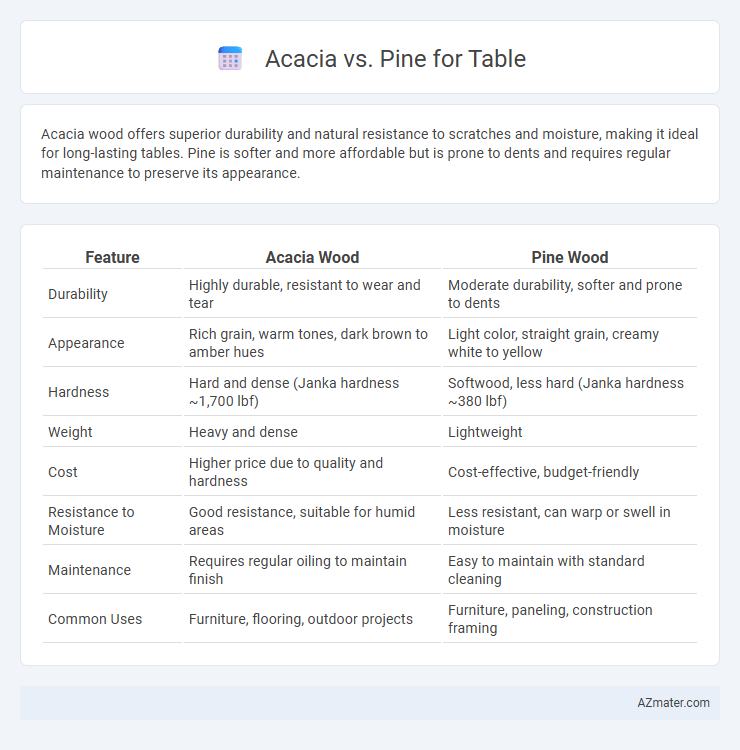Acacia wood offers superior durability and natural resistance to scratches and moisture, making it ideal for long-lasting tables. Pine is softer and more affordable but is prone to dents and requires regular maintenance to preserve its appearance.
Table of Comparison
| Feature | Acacia Wood | Pine Wood |
|---|---|---|
| Durability | Highly durable, resistant to wear and tear | Moderate durability, softer and prone to dents |
| Appearance | Rich grain, warm tones, dark brown to amber hues | Light color, straight grain, creamy white to yellow |
| Hardness | Hard and dense (Janka hardness ~1,700 lbf) | Softwood, less hard (Janka hardness ~380 lbf) |
| Weight | Heavy and dense | Lightweight |
| Cost | Higher price due to quality and hardness | Cost-effective, budget-friendly |
| Resistance to Moisture | Good resistance, suitable for humid areas | Less resistant, can warp or swell in moisture |
| Maintenance | Requires regular oiling to maintain finish | Easy to maintain with standard cleaning |
| Common Uses | Furniture, flooring, outdoor projects | Furniture, paneling, construction framing |
Introduction to Acacia and Pine Wood
Acacia wood is a durable hardwood known for its rich grain patterns and natural resistance to water and wear, making it a popular choice for high-quality tables. Pine wood, a softwood with a lighter color and pronounced knots, offers affordability and ease of staining but is more prone to dents and scratches. When comparing Acacia and Pine for table construction, Acacia provides superior strength and longevity, while Pine appeals for its cost-effectiveness and rustic charm.
Origin and Availability of Acacia and Pine
Acacia wood primarily originates from Australia and Africa, known for its dense, durable properties and unique grain patterns, making it a popular choice for tables that require strength and aesthetic appeal. Pine, widely available across North America and Europe, is a softwood recognized for its lighter weight and affordability, making it accessible and cost-effective for table construction. Availability of Acacia is more limited and can be seasonal, while Pine is abundant year-round, influencing their respective market prices and sustainability considerations.
Appearance and Grain Patterns
Acacia wood features a rich, warm hue with a strikingly varied grain pattern that includes swirls and distinctive knots, providing a unique and rustic aesthetic ideal for tables. Pine displays a lighter color palette with a more uniform, straight grain pattern that offers a classic and clean look suited for versatile design styles. The bold contrast and textural depth of acacia make it a preferred choice for statement pieces, while pine's consistency enhances simpler, traditional table designs.
Durability and Hardness Comparison
Acacia wood offers exceptional durability and hardness, making it highly resistant to scratches and dents, which is ideal for heavy-use tables. Pine, being a softer wood, is more prone to dents and surface damage but remains a popular choice due to its affordability and ease of workability. When prioritizing long-lasting furniture, acacia tables typically outperform pine in terms of strength and wear resistance.
Resistance to Scratches and Dents
Acacia wood offers superior resistance to scratches and dents compared to pine, thanks to its higher Janka hardness rating of approximately 1,070, making it a durable choice for tables in high-traffic areas. Pine, with a lower hardness rating of around 380, is softer and more prone to dents and surface marks, requiring more careful handling and maintenance. Choosing Acacia ensures long-lasting table surfaces that better withstand daily wear and tear, preserving aesthetic quality over time.
Maintenance and Care Requirements
Acacia wood requires regular oiling to maintain its rich color and prevent drying, while pine demands frequent sealing to guard against moisture and dents. Acacia is naturally resistant to scratches and water damage, making it easier to clean with mild soap and water, whereas pine is softer and more prone to scratches and stains, requiring gentle cleaning and occasional sanding. Both woods benefit from protective finishes, but acacia's durability significantly reduces the frequency of maintenance compared to pine.
Sustainability and Environmental Impact
Acacia wood is a fast-growing hardwood known for its durability and lower environmental footprint due to rapid replenishment and minimal chemical treatments. Pine, a softwood, grows quickly and is widely available, but often requires more preservatives to resist decay, impacting its eco-friendliness. Choosing Acacia over Pine for tables typically enhances sustainability because of its resilience and ability to thrive in diverse ecosystems with less intervention.
Cost and Affordability
Acacia wood is generally more expensive than pine due to its durability, attractive grain, and resistance to moisture, making it a premium choice for tables that last longer. Pine, being a softwood, is more affordable and widely available, making it a budget-friendly option for table construction, though it may require more maintenance over time. For cost-conscious buyers, pine offers excellent affordability, while Acacia provides better long-term value despite a higher initial price.
Best Use Cases for Acacia and Pine Tables
Acacia tables are best suited for rustic or farmhouse-style interiors due to their rich grain patterns and natural durability, making them ideal for dining and accent furniture that benefit from a warm, handcrafted look. Pine tables offer a lighter, more affordable option with a softer wood texture, perfect for casual settings, children's furniture, or pieces that may require easy refinishing or painting over time. Both woods provide versatility, but acacia's hardwood properties excel in high-traffic areas, while pine's lightweight nature lends itself well to adaptable, budget-friendly furniture.
Final Verdict: Choosing Between Acacia and Pine Tables
Acacia wood tables offer superior durability and a rich, warm grain, making them ideal for heavy use and long-term investment. Pine tables provide a lighter, more affordable option with a softer texture but may require more maintenance due to susceptibility to dents and scratches. Choosing between acacia and pine tables depends on balancing cost, aesthetic preference, and durability needs.

Infographic: Acacia vs Pine for Table
 azmater.com
azmater.com